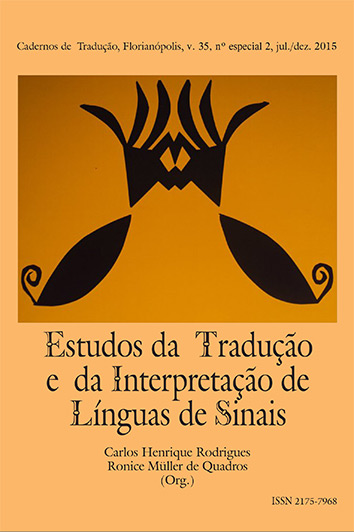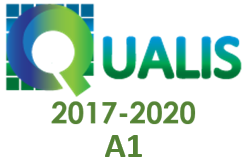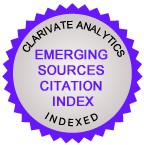Enunciative analysis of modals in libras-portuguese simultaneous interpretation's corpus
DOI:
https://doi.org/10.5007/2175-7968.2015v35nesp2p289Abstract
This paper focuses on the work of the sign Language interpreter in the condition of a second speaker within the speech production. These professionals, when interpreting, they look for re-create [actualize] the emanated concepts from the source language into the target language, creating, then, a second enunciative instance. The theoretical basis is situated in the perspective of the theory of enunciation (BENVENISTE, 1989; FLORES, 2008, 2009a, 2009b, 2010) and in the study of the modals in spoken languages and LIBRAS. We aim to find what are the marks left in the discourse by the second speaker of the text, in this case, the interpreter, regarding specifically to the use of modals, and additionally, to analyze their choices for using one or other type of modal (in the target text), which might have been made explicit or implicit in the first enunciative context (source text). In order to reach these goals, sampling was composed by a transcription of a video-recorded speech of a deaf person with the length of 40’ (forty minutes) that was being simultaneously interpreted into spoken Portuguese. Six excerpts from the total speech, in which modal’s occurrences were attested within the source or target language, were submitted to the analysis. The main findings are: 1. the tendency of the deontic modality being almost always interpreted in the same way of the source language; 2. the interpreting choices are always guided by enunciative clues that are left in the speech of the first speaker, to which the interpreters must to demonstrate expertise in recognizing these language-specific aspects; 3. in the absence of explicit modals in the speech, the interpreters appears to be sensible to the modal’s notions spread by the whole text’s surface; 4. the temporal omission of epistemic modals with a high degree of certainty is understood as an interpretative strategy and not as an infidelity with the original information; 5. the term “tempo de checagem” is being proposed to cover the lack of a specific term that refers to the non-chronological time in which the interpreter, after receiving the source language information, make the interpretation available to the listeners.References
BENVENISTE, Émile. Problemas de linguística geral I. Trad. Maria da Glória Novak; Maria Luisa Neri. Ver. Isaac Nicolau Salum. 5.ed. Campinas, SP: Pontes, 2005.
CASTILHO, Ataliba, T. & CASTILHO, Célia Maria M. de. Advérbios Modalizadores. In: ILARI, Rodolfo (Org.) Gramática do Português Falado. Vol. II. Campinas: Editora da Unicamp, 1992. pp. 213-260.
CERVONI, Jean. A enunciação. Trad: L. Garcia dos Santos. São Paulo: Ática, 1989.
FRYDRYCH, Laura Amaral Kümmel; SURREAUX, Luiza Milano. Transcrição de LIBRAS na perspectiva da linguística da enunciação. In: Anais do II Congresso nacional de pesquisas em tradução e interpretação de LIBRAS e língua portuguesa, Florianópolis, SC, 2010. Disponível em: http://www.congressotils.com.br/anais.html. Acesso em: 30/03/2012.
FELIPE, Tânia Amaral. LIBRAS em Contexto. Rio de Janeiro: FENEIS, 2005
_____________. A relação sintático-semântica dos verbos e seus argumentos na LIBRAS. Tese de doutorado. UFRJ. Rio de Janeiro, 1998.
_______________. O signo gestual-visual e sua estrutura frasal na LSCB. Dissertação de Mestrado. UFPE. Recife. 1988.
FERREIRA-BRITO, Lucinda. Por uma gramática de línguas de sinais. Rio de Janeiro: Tempo Brasileiro, 1995.
FERREIRA-BRITO, Lucinda. Epistemic, alethic, and deontic modalities in a Brazilian Sign Language. In: FISCHER, Susan D. & SIPLE, Patricia (Eds.). Theoretical issues in sign languageresearch. v. 1: Linguistics, 224–260. Chicago: University of Chicago Press, 1990.
FLORES, Valdir do Nascimento . Introdução à linguística da enunciação. 2.ed. São Paulo: Contexto, 2010.
________________ et al (Orgs.). Dicionário de linguística da enunciação. São Paulo: Contexto, 2009a.
__________. et al. Dicionário de linguística da enunciação. São Paulo: Contexto, 2009b.
________________. et al. Enunciação e gramática. São Paulo: Contexto, 2008.
FLORES, Valdir do Nascimento; TEXEIRA, Marlene. Introdução à linguística da enunciação. 2.ed. São Paulo: Contexto, 2010.
GILE, Daniel. Fidelity Assessment in Consecutive Interpretation: An Experiment. Target, 1995b. In: __________. Consecutive Vs. Simulatenous: Which is more accurate?. Interpretation Studies, No.1, December, pp.8-20, 2001.
HERRMANN, Annika; STEINBACH, Markus (Eds.). Nonmanuals in sign language. Amsterdam/Philadelphia: John Benjamins Publishing, 2013.
LYONS, John. Lingua(gem) e Linguística: uma introdução. Rio de Janeiro: LTC, 2013.
METZGER, Melanie. Deconstructing the myth of neutrality. Washigton D.C: GU Press, 2011.
METZGER, Melanie. Sign Language Interpreting: Deconstructing the Myth of Neutrality. Washington, D.C: GU press, 2002.
NAPIER, Jemina; MCKEE, Rachel; GOSWELL, Della. Sign Language Interpreting: theory and practice in Australia and New Zealand. Austrália: The Federation Press, 2006.
PEREIRA, Maria Cristina Pires. Testes de proficiência linguística em línguas de sinais: as possibilidades para os intérpretes de LIBRAS.Dissertação (Mestrado em linguística aplicada) – UNISSINOS, São Leopoldo, 2008.
QUADROS, Ronice Müller de. Phrase Structure of Brazilian Sign Language. Tese de Doutorado - Programa de Pós-graduação em Linguística e Letras. Universidade Católica do Rio Grande do Sul, PUCRS. 1999.
______________. As categorias vazias pronominais: uma análise alternativa com base na Língua Brasileira de Sinais e reflexos no processo de aquisição. Dissertação de Mestrado – Programa de Pós-graduação em Linguística e Letras. Universidade Católica do Rio Grande do Sul, PUCRS. 1995.
QUADROS, Ronice Müller de; KARNOPP, Lodenir. Língua de sinais brasileira: estudos lingüísticos. Porto Alegre: Artmed, 2004.
XAVIER, André Nogueira; WILCOX, Sherman. Necessity and possibility modals in Brazilian Sign Language (LIBRAS). In: Linguistic Typology, 18(3): 2014, pp. 449 – 488.
ZAVAGLIA, Adriana. Da invariância da linguagem à variância das línguas: contribuição para a elaboração de uma teoria enunciativa da tradução como um caso particular de paráfrase. Tese (Doutorado em Letras) - UNESP, Araraquara, SP, 2002.
Downloads
Published
How to Cite
Issue
Section
License
Copyright Notice
Authors hold the copyright and grant the journal the right for their articles' first publication, being their works simultaneously licensed under the Creative Commons Attribution License (CC BY), which allows the sharing of such works with its authorship acknowledged and its initial publication in this journal.
Authors are allowed to enter into separate additional contractual arrangements for the non-exclusive distribution of the journal's published version of the work (e.g., post it to an institutional repository or as a book chapter, with an acknowledgment of its initial publication in this journal).






















































